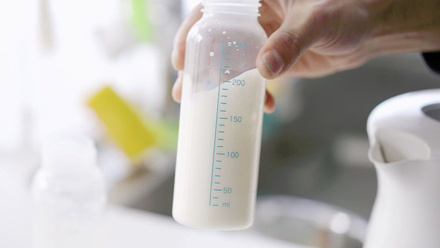By Community Paediatric Dietitian, Louise Calland
Managing cow's milk allergy is often a challenge for CCGs and community services. In particular, non IgE mediated cow's milk allergy can often be difficult to diagnose due the nature of the onset of symptoms and the similarity with other symptoms often seen in infancy such as colic and reflux.
Many CCGs have seen an increase in the prescribing of specialist infant formulas with costs increasing year on year and frequently accompanied by a rising demand on dietetic services. Three years ago, Bolton CCG was in a similar position to many others nationally, with an increase in spending on specialist infant formulas by an average of 20-30% every year during the previous five to six years.
During this time, there was also an increase in referrals to the community dietetic service. Referrals were often made when infants had been on an extensively hydrolysed (EHF) or amino-acid based formula (AAF) for many weeks or months and usually when complementary feeding was due to start at six months. Sometimes, the infant was already established on a varied diet, with foods containing cow's milk but still drinking an EHF or even an AAF-based formula and with a limited history about original symptoms.
This article is a summary of a project carried out by a paediatric dietitian to identify current prescribing practice across Bolton CCG, introduce interventions which would help achieve cost efficiencies and improve the patient experience and outcome for infants with suspected non IgE cow's milk allergy.
Cow's milk allergy is estimated to affect 3-7% of infants (2 see references below). Guidelines suggest that infants with delayed onset mild to moderate symptoms can be managed in primary care (1,2). Most infants referred to the Bolton community dietetic service have a history of mild to moderate symptoms or those typical of a non IgE mediated reaction. Nearly all infants referred, previously had remained on formula because symptoms had improved but had not had a confirmed diagnosis with a home reintroduction after two to four weeks on an EHF, as recommended in national guidance (1,2).
The project aims
A piece of work was therefore carried out for the Medicines Optimisation Team within the CCG. The work was carried out by a paediatric dietitian on a secondment two days a week. The aim was to look at current spending and to see if any savings could be made, and also to look at possible alternative ways of managing infants with suspected cow's milk allergy.
The initial approach taken was to audit GP records to assess the types of formula prescribed, the age of the children on formula and whether or not they were currently receiving any kind of dietetic review. Over 30 GP practices were audited and over 200 children's records. For children not currently seen by dietetics, a review appointment was offered.
An audit was also carried out to look at the most common reason for parents seeking help from the GP or starting a specialist formula. The frequency of reported symptoms at this time was audited. The most frequently reported reason for starting an EHF was reflux or vomiting, with one out of every four reported symptoms falling into this category.
None of the infants had gone on to have a home reintroduction after two to four weeks on an EHF to confirm cow's milk allergy. Many had been started on EHF without having an assessment of feeding or an allergy-focused clinical history. Management was often alongside intervention for reflux which was often given at the same time as starting EHF rather than using a stepped approach for gastro-oesophageal reflux disease (3). 50% of the infants were receiving alginate therapy for reflux. 30% of the formula prescribed was amino acid rather than EHF. Some children as old as six years were still having a regular prescription for formula.
In view of these findings, the following interventions were introduced:
1. A guideline was developed - to encourage first line treatment to be an EHF where possible and to use the most cost-effective products on the market. This was agreed with the CCG and sent to all GPs and health visitors.
2. Training for health visitors and GPs - was given to encourage the correct management for symptoms of reflux, feeding problems and eczema before starting an EHF. This is because the audit identified that many infants had been started on EHF without having an assessment of feeding or an allergy-focused clinical history. Due to lack of training, many health visitors often asked parents to seek help from the GP. Assessment tools/ management plans were introduced for health visitors to look for signs of poor feeding practices, overfeeding or functional gastrointestinal symptoms such as colic or reflux.
3. A pilot rapid access dietitian-led clinic was started - for infants with suspected mild to moderate cow's milk allergy. The clinic was a way of ensuring that infants who required a two to four week trial of EHF could then have a home reintroduction to confirm cow's milk allergy. Referrals were accepted from health visitors, GPs and paediatricians. Families were seen within wo weeks.
An allergy-focused clinical history was carried out by the dietitian and infants started on a two to four - week trial of an EHF, which was requested on prescription as a trial from the GP. Follow-up was then done by telephone and, in line with national guidance, a home reintroduction was advised where symptoms had resolved in this time and initial symptoms were delayed onset and mild to moderate (non IgE). If confirmed, a letter was sent to the GP with a request for ongoing prescriptions and a time frame for them to continue and a stop date when the child was one year.
Any infants with confirmed cow's milk allergy were passed on to the general dietetic clinic for advice about introducing a cow's milk free diet at five to six months and challenge with the milk ladder, usually between nine to twelve months of age.
Results
The results show that out of 185 new referrals in the first year only 60% had cow's milk allergy and 40% did not have a confirmed diagnosis. Almost 28% of those referred were not assessed as having cow's milk allergy and did not start an EHF, often being referred back to the health visitor for feeding advice. Only 24% were actually confirmed following a home reintroduction. Approximately one-third of infants were not able to have a home reintroduction. This was often for reasons such as requiring an AAF due to unresolved symptoms on EHF, already being on an EHF for longer than four-to six weeks or parental refusal due to the significant improvement on EHF and clinical decision based on the severity of original symptoms.
The graph above also shows that there has been no further increase in spending and the spending in the first part of the financial year 2017-2018 is £30,000 less than in the same period in 2016-2017. If this trend does continue the reduction in spend could be £60,000 for the year.
Positive outcomes
The funding for this dietetic work has now been made permanent by the CCG. The clinic runs once each week and there is much closer working with health visitors and GPs. The patient experience is improved with infants seen quickly and cost-effective interventions started much earlier. Confirmation of diagnosis is a clearer process with fewer infants staying on specialist formulas unnecessarily and cost savings achieved.
References
1. Carina Venter.Trevor Brown. Rosan Meyar. Joanne Walsh. Neil Shah .Anna NowakW grzyn. Tong-Xin Chen. David M. Fleischer. Ralf G. Heine. Michael Levin. Mario C. Vieira and Adam T.
Fox. Better recognition, diagnosis and management of non-IgE mediated cow's milk allergy in infancy. iMAP, an international interpretation of the MAP (Milk Allergy in Primary Care) guideline. Clinical and Translational Allergy20177:26
2. NICE (2015) Cows' Milk Protein Allergy in children,
3. NICE guidelines (2015) Gastro-oesophageal Reflux Disease: recognition, diagnosis and management in children and young people.







